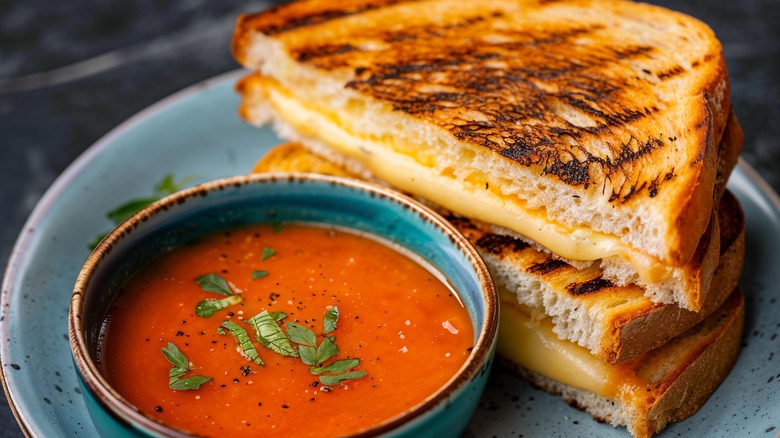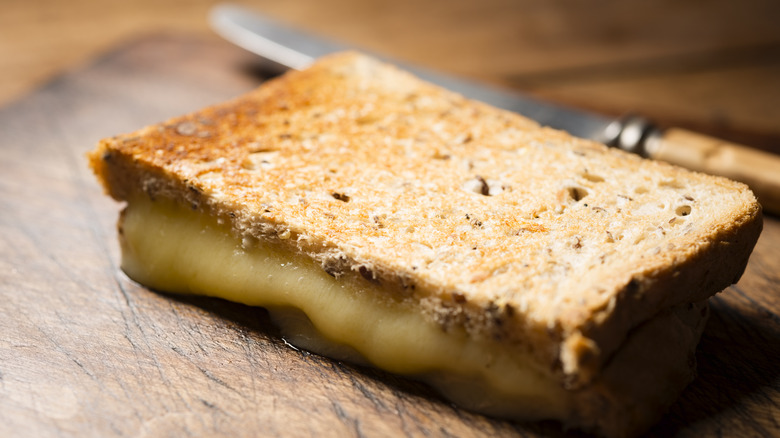The Subtle Difference Between A Grilled Cheese And English Toastie
Cheese and bread are a treasured duo in culinary cultures around the world, each with its own distinct twist on the pairing. In America and Great Britain, the grilled cheese and cheese toastie are the respective favorites for integrating this beloved duo. Both the American grilled cheese and the English toastie consist of bread, cheese, and copious amounts of butter. They both offer that irresistible textural contrast between the toasted, crunchy bread and gooey melted cheese center. They're also both open to variations on types of cheese, bread, and even additional fillings.
If you ordered an English toastie at a restaurant, you'd probably think that the two are synonymous at first glance. In fact, both British and American eaters describe the cheese toastie as a British grilled cheese and a grilled cheese as an American cheese toastie. However, the subtle yet distinct difference between a grilled cheese and a toastie lies more in the cooking method, preparation, and accompaniments.
What is a grilled cheese?
Popularized during the 1920s, grilled cheese sandwiches coincided with the age of the industrialization of processed foods. With cheap mass-produced products like pre-sliced sandwich bread and processed American cheese, the grilled cheese sandwich was quite literally the best thing since sliced bread. While the type of bread and cheese has now come to encompass a wide range of gourmet and all natural options, the steps and tools to make a grilled cheese remain the same.
The American preparation starts with adding butter or mayonnaise to the outside of each bread slice, adding cheese, then frying the sandwich in a skillet, griddle, or frying pan. The bread gets crispy and browns quickly while the butter infuses flavor and saturates the bread with moisture. Grilled cheese sandwiches are enjoyed as snacks and even more popularly as lunch or dinner items. We love pairing them with tomato soup or simply a side of ketchup. The height of comfort food, these pan-fried sandwiches are golden brown and known for their creamy, gooey centers that create the ultimate cheese pull with every bite.
What is an English toastie?
The first recorded recipe for a cheese toastie comes from an 1861 English cookbook, and many argue that the toastie was the precursor to the American grilled cheese sandwich. However, the distinguishing characteristic between the toastie and the grilled cheese starts with buttering the bread from the inside instead of the outside. The buttered side of bread is topped with slices or shredded cheese. Of course, American cheese singles don't factor into the cheese toastie, but instead a rich, sharp cheese like cheddar is used, or milder Cheshire cheese that was particularly popular during the 19th and early 20th centuries.
The biggest difference lies in the cooking method, which is inherent in the name of the two sandwiches. Grilled cheese sandwiches are exposed directly to the heat of the skillet, but toasties are, well, toasted. They're either baked in the oven or toaster baskets. Since they're not buttered on the outside nor touching the heat source, the bread on toasties is dry and airy, like a piece of toast. However, it is also common to make them in an electric sandwich toaster. Toasties also take considerably longer to cook. Plus, many Brits claim that the original toastie is an open-faced sandwich called cheese on toast, wherein cheese is placed onto toasted bread and placed under a grill becoming bubbly with bits of char. Instead of ketchup or tomato soup, Brits often enjoy their cheese toasties dotted with drops of Worcestershire sauce.


